The field of ایریدولوژی relies heavily on precise optical equipment to analyze the intricate patterns and colorations in the iris. Selecting the right iridology lenses can significantly impact diagnostic accuracy and patient experience. This comprehensive guide examines various lens types, magnification levels, lighting systems, and technical specifications to help practitioners and enthusiasts make informed decisions when investing in iridology equipment.
Understanding the Role of Iridology Lenses in Eye Analysis
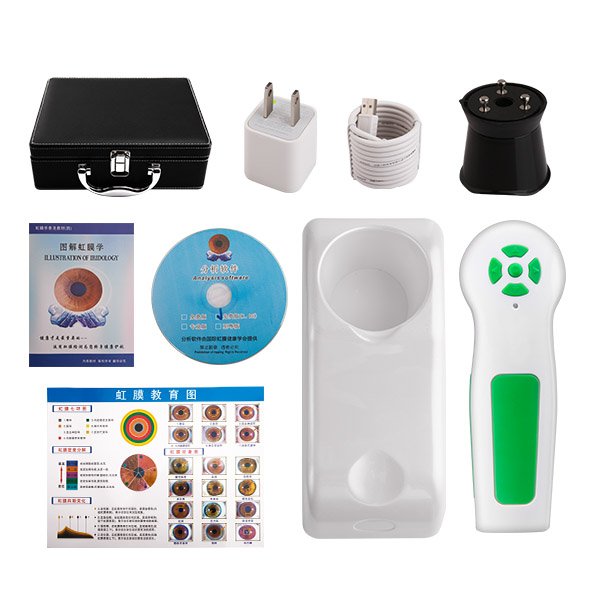

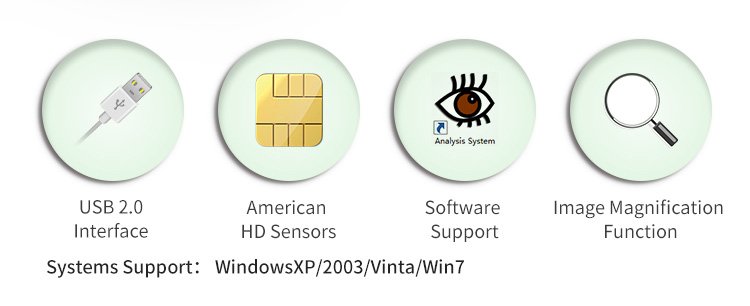
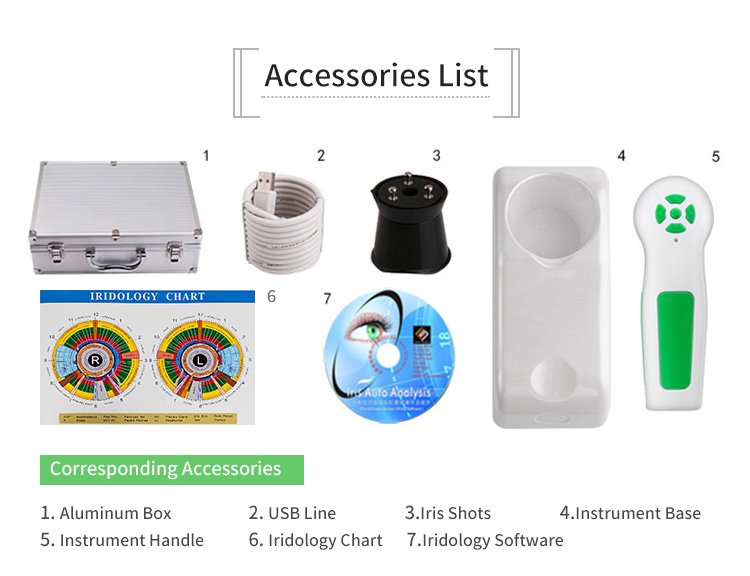
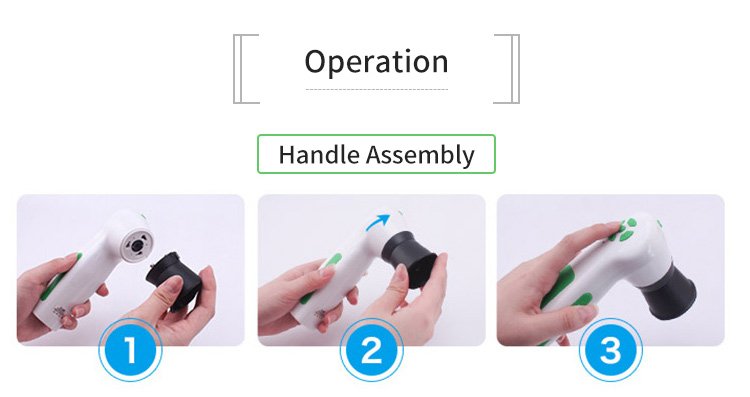


High-quality iridology lens revealing detailed iris structures
Iridology lenses serve as the critical interface between the practitioner and the intricate details of the iris. These specialized optical tools magnify the iris’s complex structures, allowing for detailed observation of colors, patterns, and markings that may indicate various health conditions according to iridology principles.
The effectiveness of iris analysis depends significantly on the quality and specifications of the lens system used. Professional-grade iridology lenses typically offer:
- Precise magnification capabilities (typically 10x to 30x)
- Integrated lighting systems for consistent illumination
- Minimal distortion at the edges of the visual field
- Comfortable positioning systems for both practitioner and client
- Compatibility with digital recording equipment
The Evolution of Iridology Lenses فناوری
The technology behind iridology lenses has evolved significantly over the decades. Early practitioners relied on simple magnifying glasses with limited capabilities. Today’s advanced systems integrate digital imaging, specialized lighting, and software analysis tools to enhance diagnostic precision.
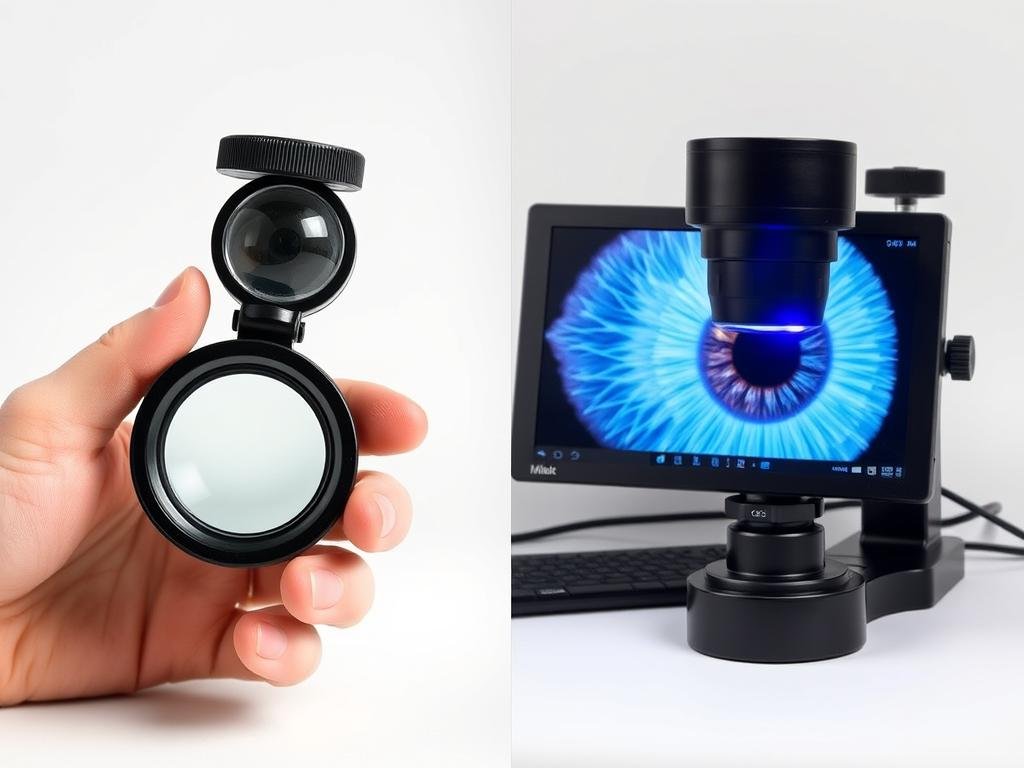
Evolution from traditional magnifiers to modern digital iridology systems
Modern advancements have transformed iridology practice by enabling:
- Digital image capture for documentation and comparison
- Enhanced visibility of subtle iris features
- Improved patient comfort during examinations
- More consistent lighting conditions for accurate color assessment
- Integration with analysis software for pattern recognition
Types of Iridology Lenses: Magnification and Material Comparisons
The market offers several distinct categories of iridology lenses, each with specific advantages for different practice settings and diagnostic needs. Understanding these differences is crucial for selecting equipment that aligns with your professional requirements.
Handheld Iridology Lenses
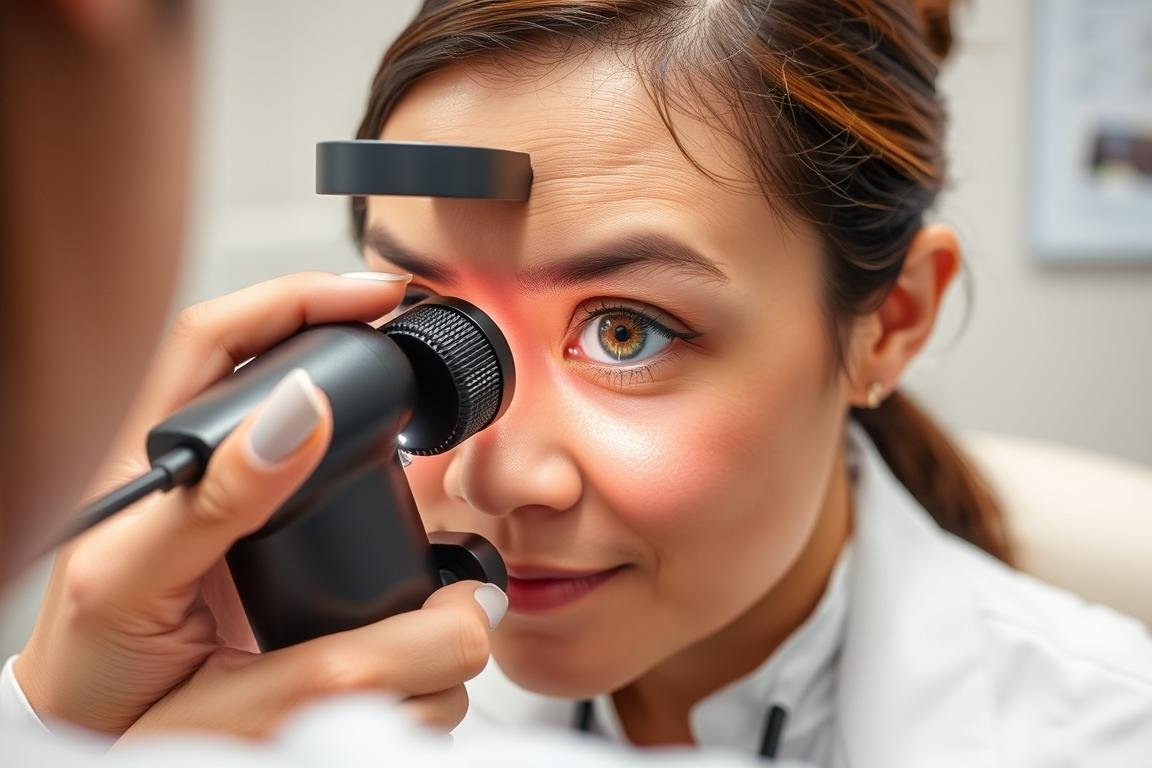
Practitioner using a handheld iridology lens for examination
Advantages
- Portable and convenient for mobile practitioners
- Generally more affordable entry point
- Simple operation with minimal technical requirements
- No dependency on power sources or computers
- Tactile control over examination angle and focus
محدودیت ها
- Lower magnification range (typically 5x-10x)
- Inconsistent lighting conditions
- No image capture capabilities
- Requires steady hand for clear viewing
- More challenging for patient record documentation
Need a Professional Recommendation?
Our experts can help you select the ideal handheld iridology lens for your specific practice needs.
از طریق WhatsApp تماس بگیرید
Slit-Lamp Iridology Lenses
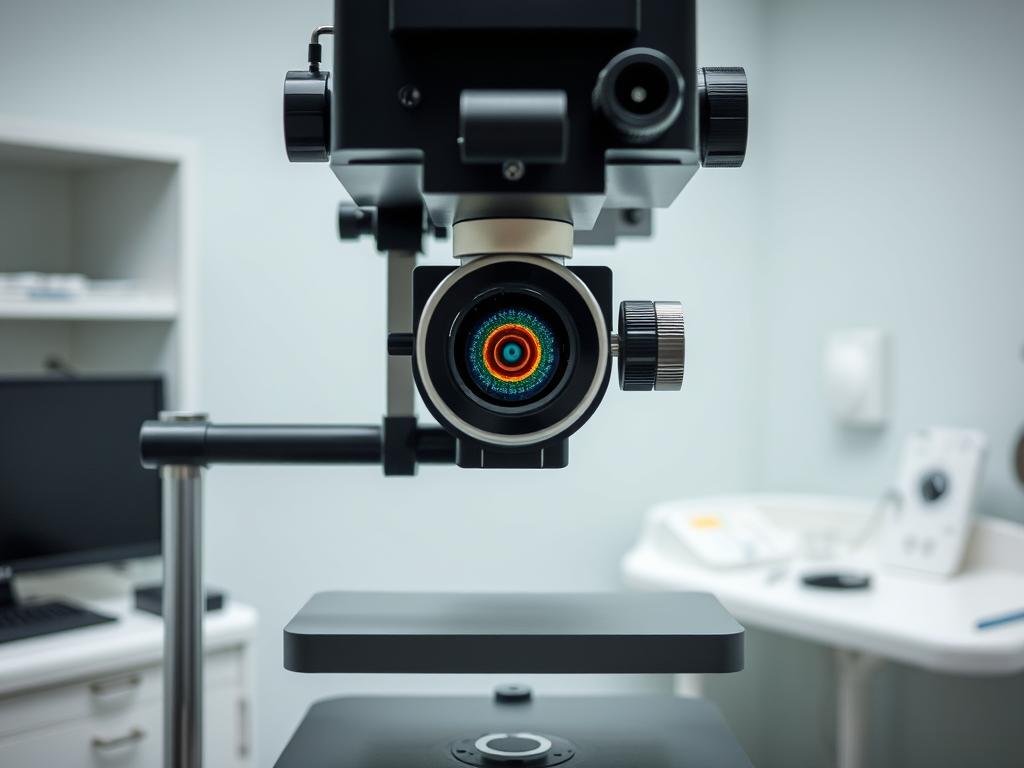
Professional slit-lamp iridology system with precision controls
Slit-lamp systems represent the gold standard for professional iridology practice, offering superior magnification and illumination control.
Magnification Quality
4.8
Key features of professional slit-lamp systems include:
- High magnification range (up to 40x)
- Precise control of light angle and intensity
- Stable positioning for both practitioner and patient
- Option for digital image capture attachments
- Ability to observe different iris depths
Digital Iridology Lenses and Camera Systems
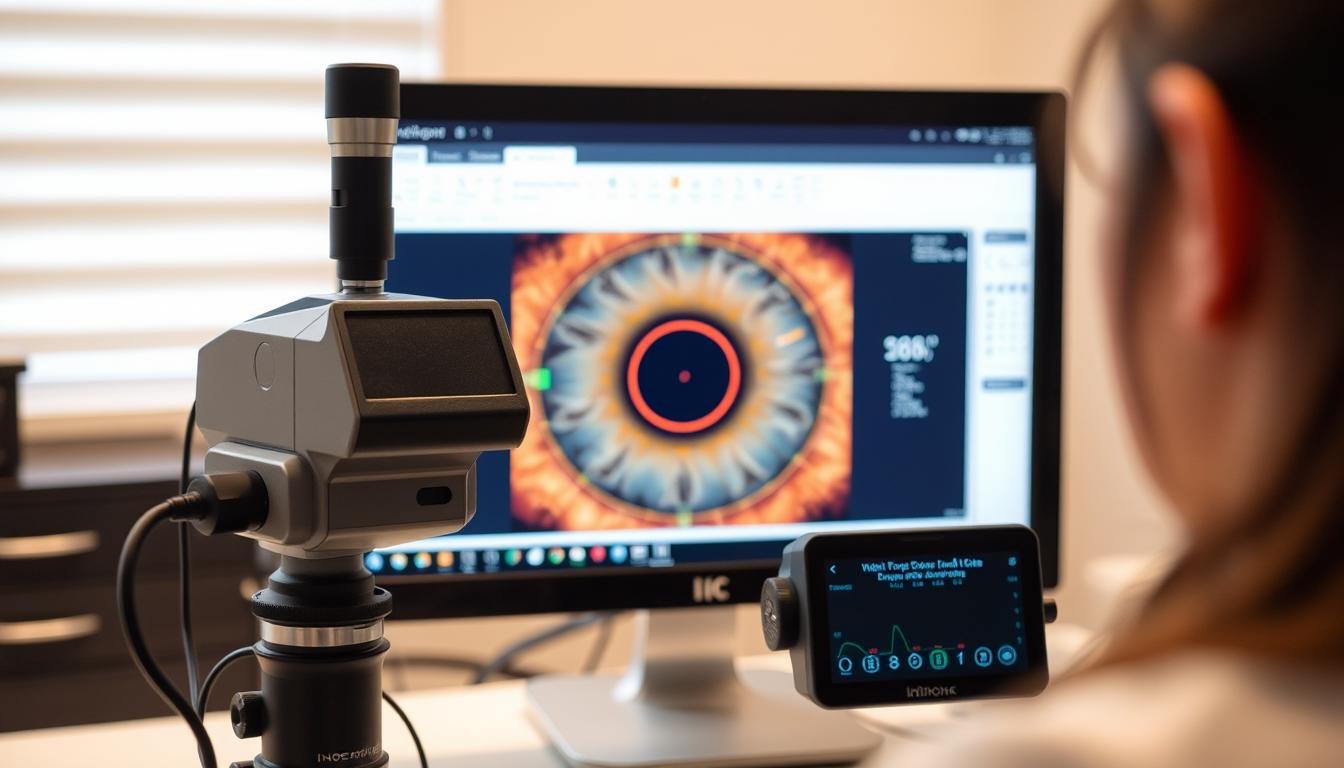
Digital iridology camera with computer analysis software
Modern digital systems represent the cutting edge of iridology technology, combining optical excellence with digital documentation and analysis capabilities.
| ویژگی |
Entry-Level Digital |
Mid-Range Digital |
Professional Digital |
| قطعنامه |
5.0 MP |
8.0 MP |
12.0+ MP |
| بزرگنمایی |
10x-20x |
20x-30x |
30x-50x |
| روشنایی |
Basic LED |
Adjustable LED |
Multi-spectrum LED |
| نرم افزار |
Basic capture |
Analysis tools |
Advanced analysis |
| Price Range |
$200-$300 |
$300-$600 |
$600-$1500+ |
Featured Product: Professional 30x Iris Analyzer
Our most popular digital iridology system combines 30x magnification with full-spectrum LED lighting and comprehensive analysis software.
- 8.0 MP high-definition CCD sensor
- Adjustable focus for crystal-clear images
- Dual image comparison functionality
- Compatible with all modern Windows systems
- Includes portable aluminum carrying case
Lighting Systems for Iridology Lenses: Key Features to Consider

Comparison of different lighting systems and their effect on iris visibility
The lighting system is perhaps the most critical component of effective iridology equipment. Different lighting technologies reveal various aspects of iris structure and coloration, significantly impacting diagnostic accuracy.
LED Lighting for Iridology Lenses
LED (Light Emitting Diode) technology has become the standard for modern iridology equipment due to its versatility and precision.
White LED Systems
White LED lighting provides neutral illumination that reveals the full spectrum of iris colors and patterns. These systems typically offer:
- Consistent color temperature (typically 5000K-6500K)
- Energy efficiency with minimal heat generation
- Long operational lifespan (20,000+ hours)
- Adjustable intensity levels
Yellow/Warm LED Systems
Specialized for examining darker irises, yellow or warm-spectrum LEDs enhance visibility of subtle patterns in brown and dark-colored eyes by:
- Providing better contrast in melanin-rich irises
- Reducing glare and reflection
- Enhancing visibility of deeper iris structures
- Creating more comfortable viewing for sensitive patients
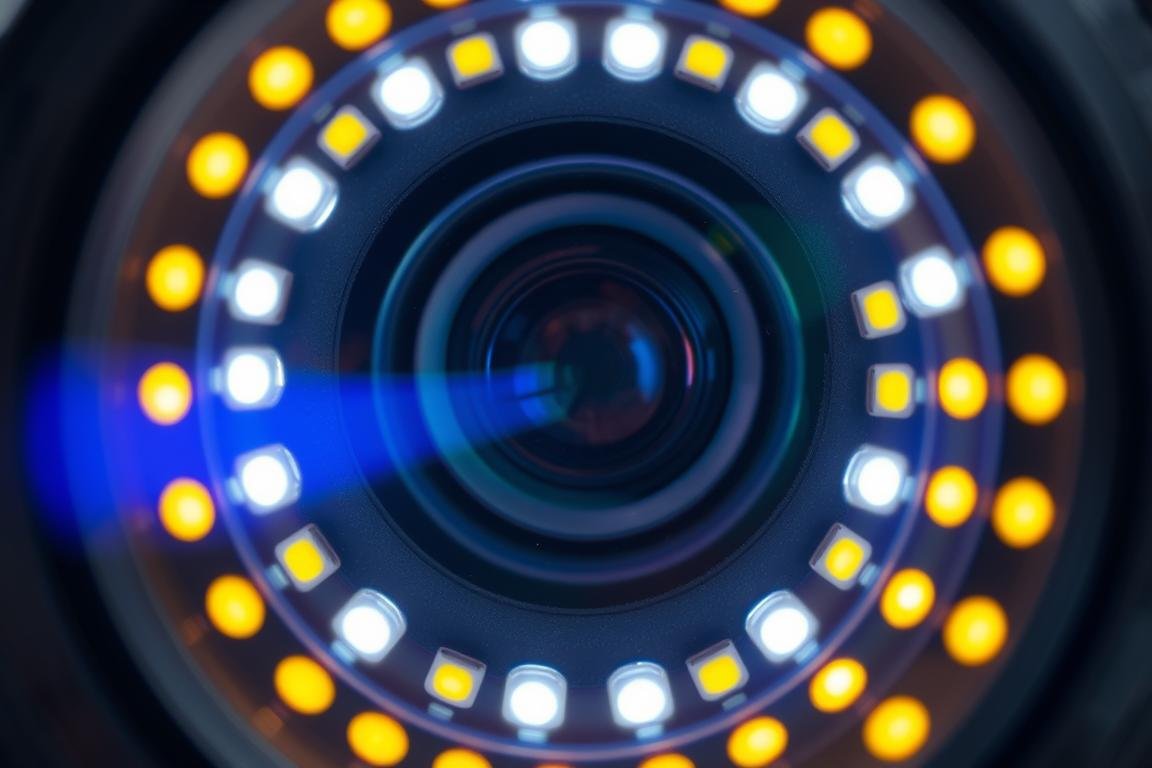
Close-up of dual-spectrum LED arrangement on professional iridology lens
Halogen Lighting Systems
Though less common in newer equipment, halogen lighting systems still have applications in specific iridology contexts.
Advantages
- Warm light spectrum enhances certain iris features
- Familiar technology for established practitioners
- Strong illumination capabilities
- Continuous spectrum similar to natural light
محدودیت ها
- Generates significant heat during operation
- Higher power consumption
- Shorter bulb lifespan (1,000-2,000 hours)
- Less precise control over light intensity
- Bulbs require periodic replacement
Full-Spectrum Natural Light Systems
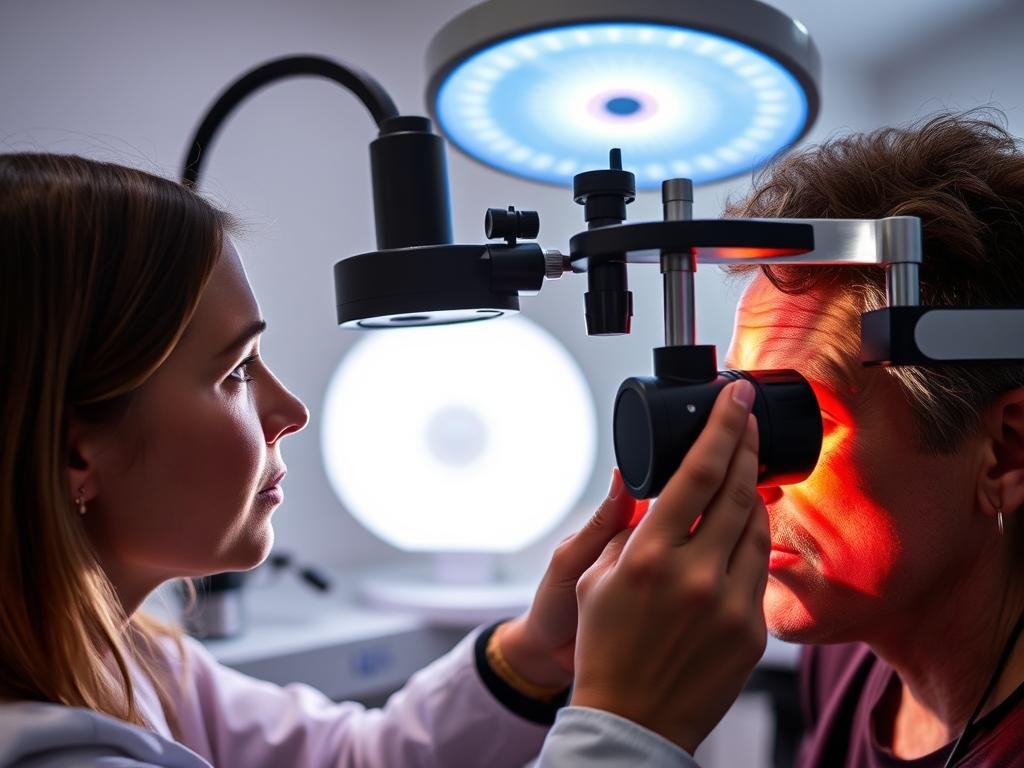
Full-spectrum lighting system simulating natural daylight for accurate color assessment
Premium iridology systems often incorporate full-spectrum lighting designed to replicate natural daylight conditions, considered optimal for accurate iris assessment.
- Color rendering index (CRI) of 90+ for true color representation
- Balanced spectrum covering the entire visible light range
- Reduced eye strain for both practitioner and patient
- Optimal for photographic documentation
- Reveals subtle color variations in the iris
“The quality of lighting in iridology examination directly impacts diagnostic accuracy. Full-spectrum lighting that closely mimics natural daylight provides the most reliable conditions for observing true iris colors and patterns.”
– Journal of Complementary Medicine Research
Magnification Levels: Finding the Optimal Balance
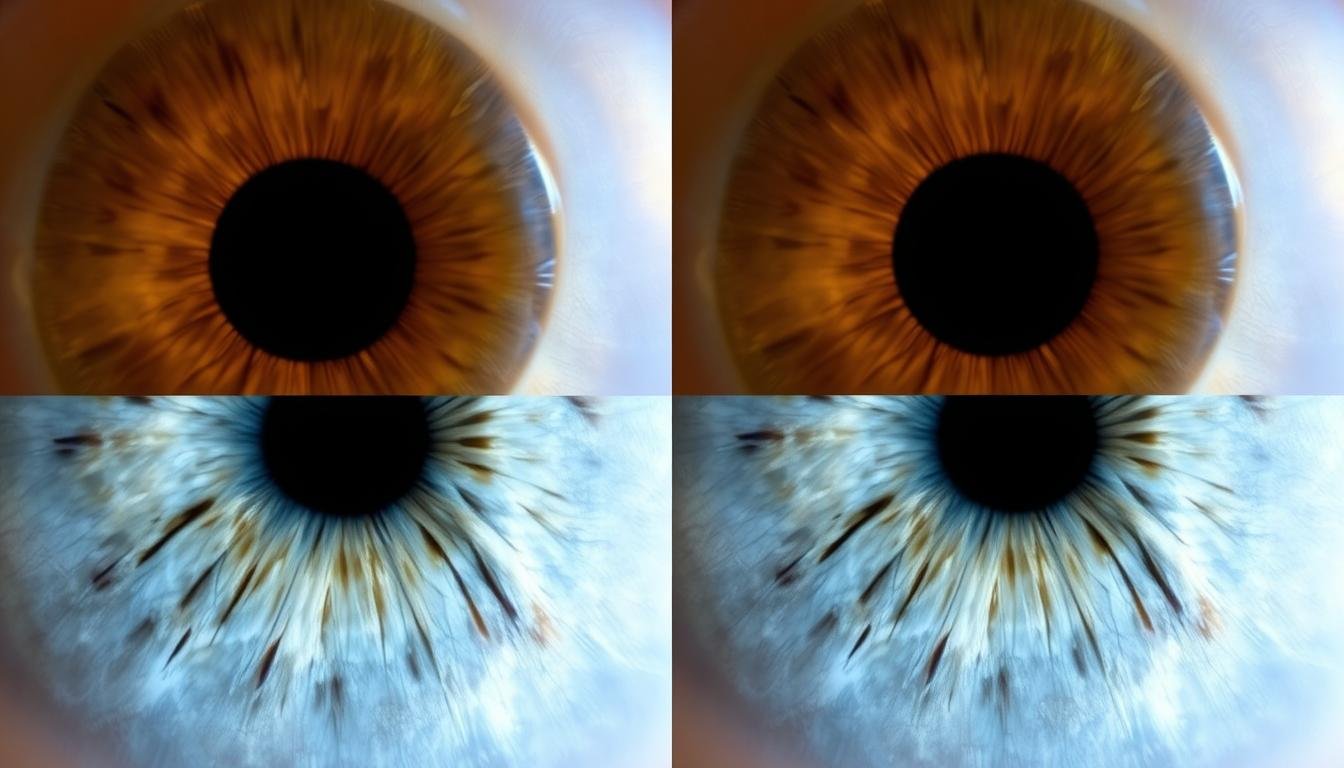
Comparison of iris detail visibility at different magnification levels
Selecting the appropriate magnification level is crucial for balancing detail visibility with practical usability in iridology practice.
| Magnification Level |
Visible Details |
Practical Applications |
محدودیت ها |
| 5x-10x |
Basic iris zones, major markings, overall color |
Initial assessment, general screening |
Misses fine details and subtle patterns |
| 10x-20x |
Zone details, fiber patterns, color variations |
Standard practice, general diagnosis |
May not reveal microscopic structures |
| 20x-30x |
Fine fibers, small lesions, detailed structures |
Detailed analysis, professional practice |
Narrower field of view, requires stability |
| 30x-50x |
Microscopic details, cellular-level structures |
Research, specialized diagnosis |
Very narrow field, requires perfect stability |
Advantages of High-Magnification Iridology Lenses
Professional-grade equipment typically offers magnification in the 20x-30x range, providing several key advantages:
- Reveals subtle iris markings not visible at lower magnifications
- Allows observation of fine iris fiber arrangements
- Enables detection of early changes in iris structures
- Provides clearer documentation for patient records
- Enhances credibility through detailed analysis capabilities
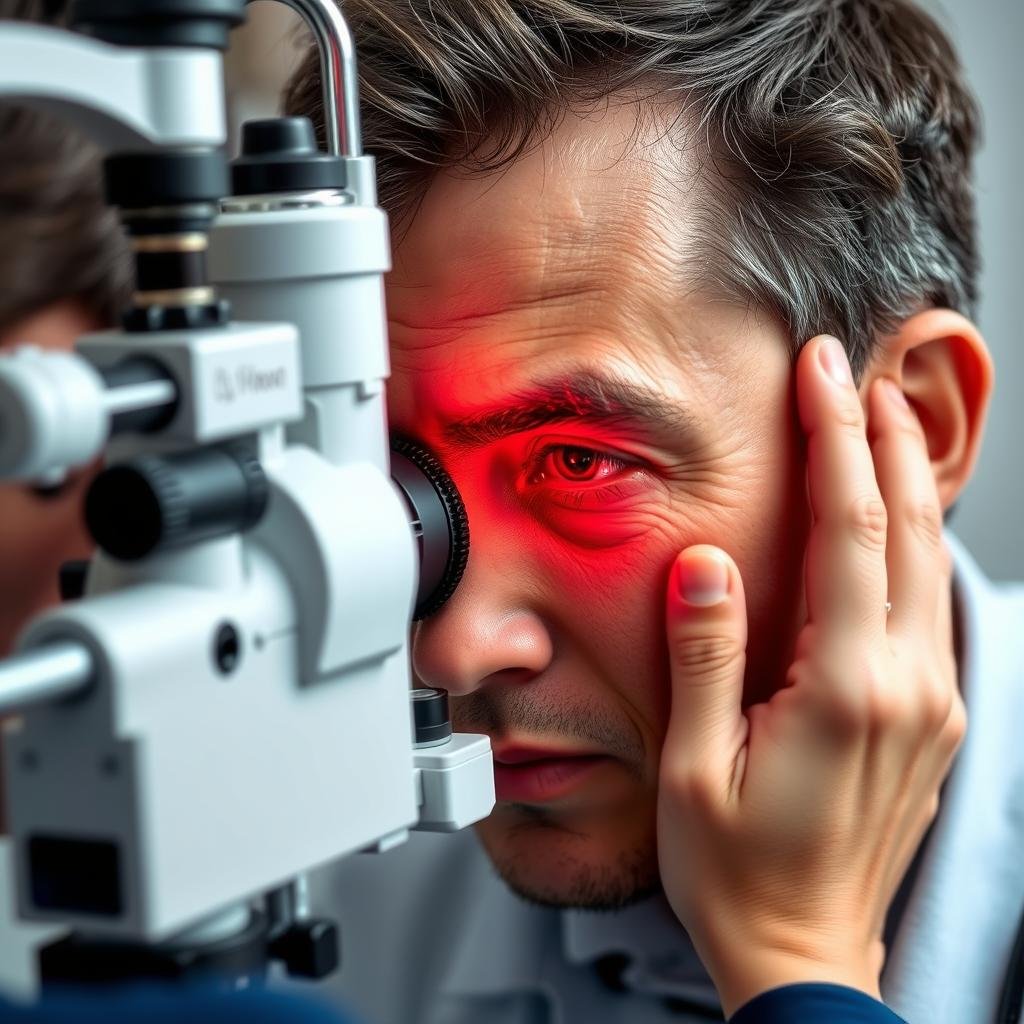
Professional iridologist using high-magnification equipment for detailed analysis
Upgrade Your Diagnostic Capabilities
Explore our range of professional-grade iridology equipment with magnification options from 10x to 30x.
Discuss Your Requirements
Software Integration with Digital Iridology Lenses
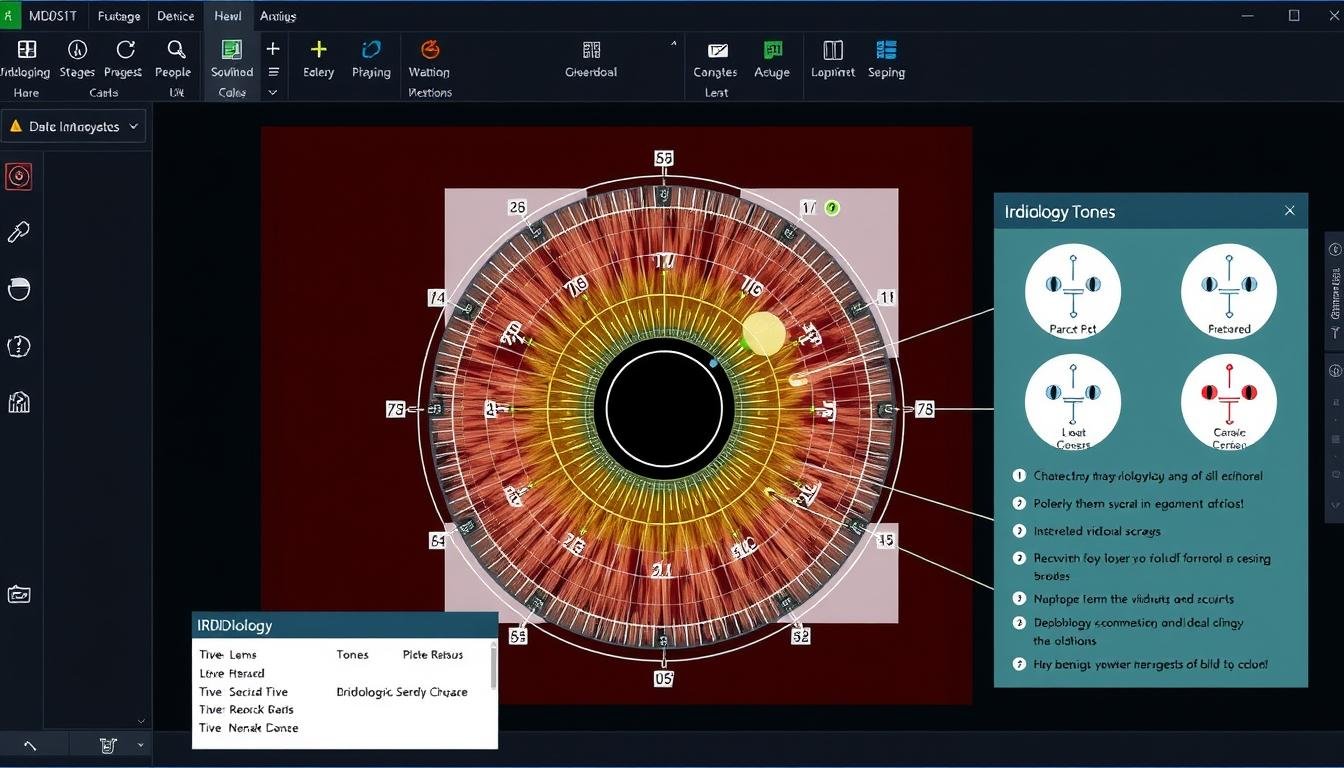
Professional iridology software interface with analysis tools and mapping
Modern digital iridology systems extend beyond optical hardware to include specialized software that enhances diagnostic capabilities and patient management.
Key Software Features
ضبط تصویر & Enhancement
- High-resolution image capture
- Automatic white balance adjustment
- Contrast and brightness optimization
- Digital zoom capabilities
- Image stabilization algorithms
Analysis Tools
- Iridology chart overlays
- Zone marking and annotation
- Color analysis and measurement
- Pattern recognition assistance
- Comparative analysis features
Patient Management
- Patient record database
- Historical comparison tools
- Report generation capabilities
- Treatment tracking features
- Secure data storage options
Advanced software systems can significantly enhance the practitioner’s ability to provide detailed analysis and maintain comprehensive patient records.
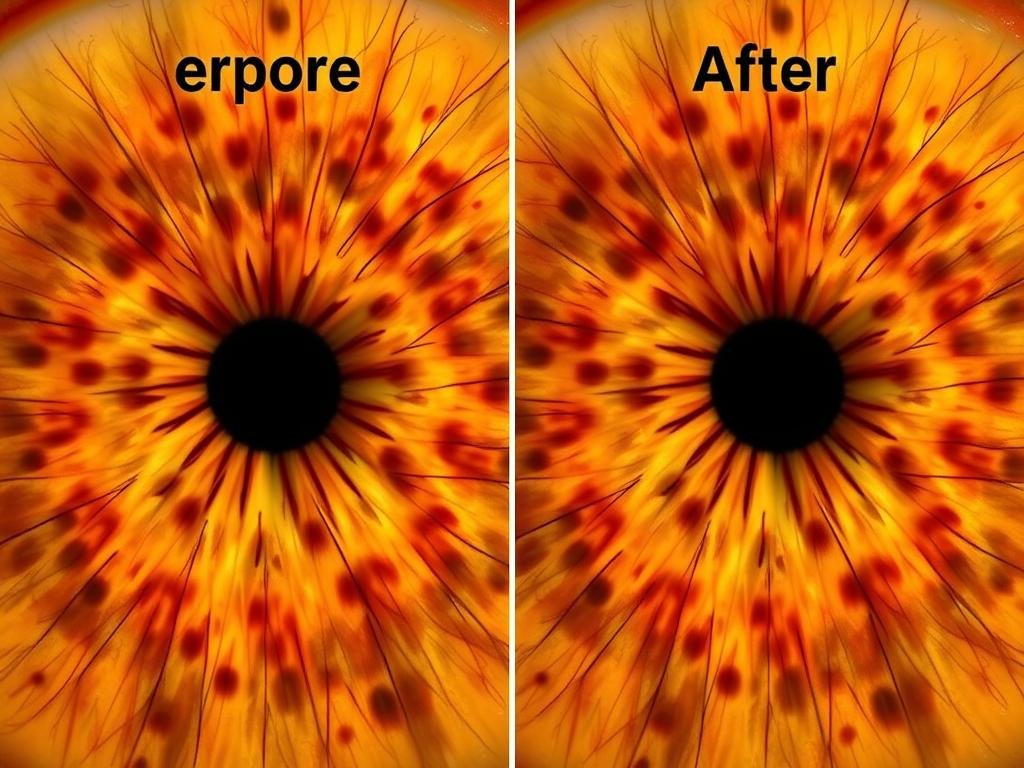
Before and after comparison showing software enhancement of iris image clarity
Software Compatibility Considerations
When selecting digital iridology systems, ensure software compatibility with your existing technology infrastructure:
- Operating system requirements (Windows, macOS, etc.)
- Computer hardware specifications needed
- Update and support policies
- Data export and backup capabilities
- Integration with other practice management systems
Practical Considerations When Choosing Iridology Lenses
Beyond technical specifications, several practical factors should influence your selection of iridology equipment to ensure it meets your specific practice needs.
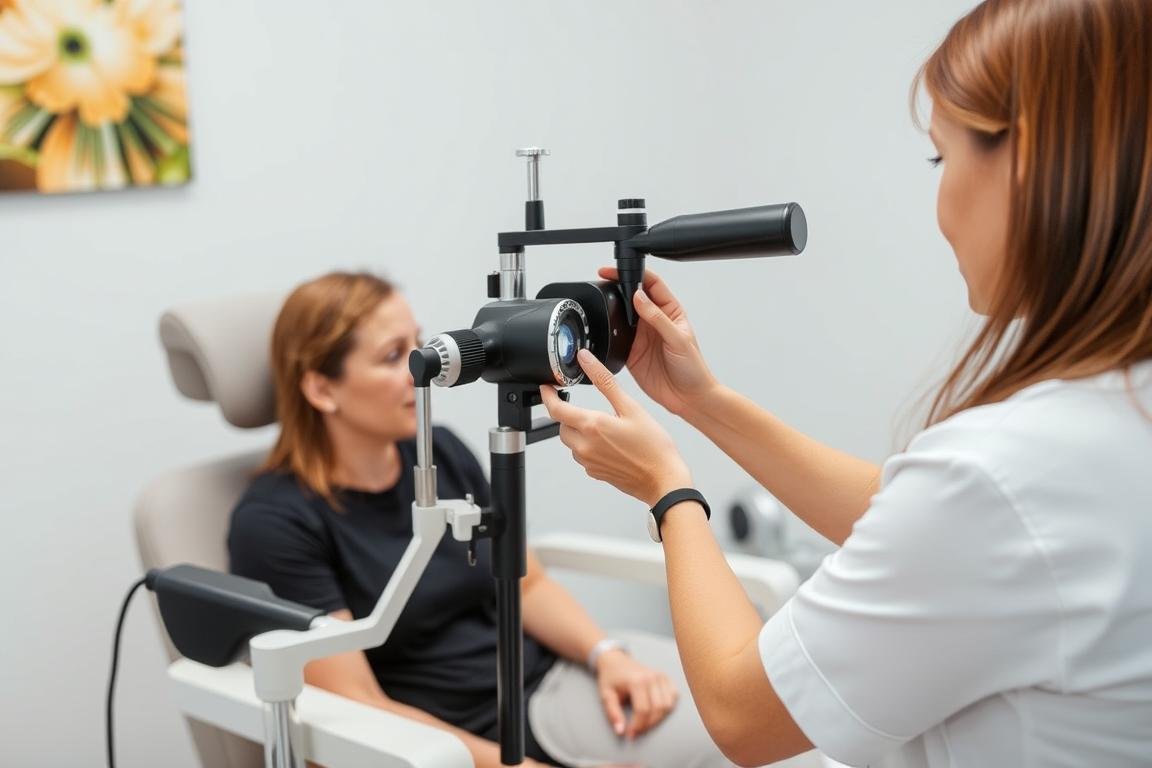
Ergonomic positioning for both practitioner and patient during examination
Ergonomics and Usability
The physical design and usability of iridology equipment significantly impacts practitioner comfort and examination efficiency.
- Weight and balance of handheld equipment
- Adjustability of stands and positioning systems
- Ease of focus and magnification adjustment
- Patient comfort during examination
- Intuitive controls and interfaces
Durability and Maintenance
Construction Quality
Professional equipment should withstand regular use in clinical settings:
- Quality of optical components
- Durability of housing materials
- Stability of adjustment mechanisms
- Protection for sensitive electronics
Maintenance Requirements
Consider the ongoing care needed to maintain optimal performance:
- Lens cleaning procedures
- Calibration requirements
- Replacement part availability
- Warranty and service options

Proper maintenance ensures longevity and optimal performance of iridology equipment
Portability Considerations
For practitioners who offer mobile services or work across multiple locations, portability becomes a crucial factor.
Portable System Essentials
- Compact, lightweight design
- Protective carrying case included
- Quick setup and breakdown process
- Battery operation or standard power requirements
- Durability for transport conditions
Investment Considerations and Return on Investment
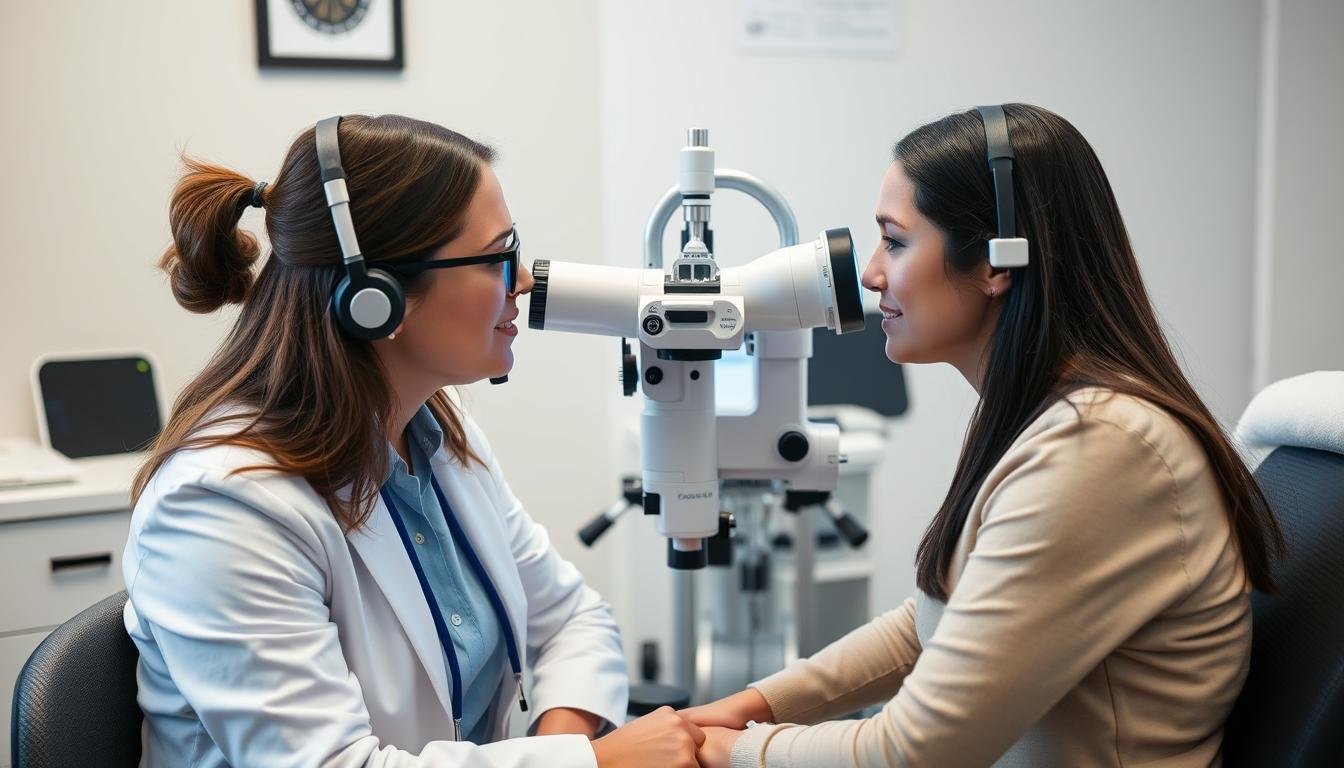
Professional iridology practice with quality equipment enhances client experience and practice success
Investing in quality iridology equipment represents a significant decision for practitioners. Understanding the relationship between investment level and potential returns helps inform this important choice.
| Equipment Level |
Approximate Investment |
Typical Applications |
مزایای احتمالی |
| Entry-Level |
$200-$500 |
Basic assessments, learning, supplementary service |
Low barrier to entry, basic functionality |
| Mid-Range |
$500-$1,000 |
General practice, standard examinations |
Good balance of quality and affordability |
| حرفه ای |
$1,000-$2,500 |
Dedicated practice, detailed analysis |
Enhanced diagnostic capabilities, client confidence |
| Premium |
$2,500+ |
Specialized clinics, research, teaching |
Maximum precision, advanced features, longevity |
Factors Affecting Return on Investment
- Enhanced diagnostic capabilities leading to improved client outcomes
- Professional image and credibility reinforcement
- Ability to document and demonstrate findings to clients
- Efficiency improvements in examination process
- Potential for offering premium services at higher rates
- Equipment longevity and durability reducing replacement costs
“The quality of diagnostic equipment directly influences both practitioner confidence and client perception of professional credibility. Investment in superior iridology tools often pays dividends through enhanced practice reputation and client satisfaction.”
– International Journal of Holistic Practice
Expert Recommendations and Selection Guide

Expert demonstration of different iridology lens systems during professional training
Based on our extensive experience supplying professional iridology equipment worldwide, we offer the following recommendations for different practitioner profiles:
For New Practitioners
- Start with a quality digital system in the mid-range ($500-$800)
- Prioritize user-friendly software with learning resources
- Select equipment with good manufacturer support
- Consider systems that allow for future upgrades
- Focus on versatility rather than specialized features
For Established Practices
- Invest in professional-grade systems ($1,000-$2,000)
- Prioritize advanced imaging capabilities and software
- Select equipment with comprehensive patient management
- Consider dual-purpose systems (iris + skin analysis)
- Focus on features that enhance client education
For Mobile Practitioners
- Select lightweight, portable systems with carrying cases
- Prioritize battery operation or standard power options
- Choose equipment with quick setup/breakdown
- Consider systems with onboard storage capabilities
- Focus on durability for transport conditions
Selection Checklist
Technical Considerations
- Determine required magnification level (10x-30x recommended)
- Evaluate lighting options (full-spectrum LED preferred)
- Assess image quality and resolution needs
- Consider software capabilities and compatibility
- Verify technical support and warranty coverage
Practical Considerations
- Evaluate ergonomics and ease of use
- Consider practice setting and mobility needs
- Assess durability and maintenance requirements
- Calculate total cost of ownership (including accessories)
- Research manufacturer reputation and longevity
Conclusion: Making an Informed Decision
Selecting the right iridology lenses and equipment represents a significant investment in your practice’s diagnostic capabilities and professional credibility. By carefully evaluating the factors discussed in this guide—magnification requirements, lighting systems, software capabilities, and practical considerations—you can make an informed decision that aligns with your specific practice needs and budget constraints.
Remember that quality iridology equipment serves not only as a diagnostic tool but also as a demonstration of your commitment to professional excellence. The right equipment enhances both your ability to provide accurate analysis and your clients’ confidence in your services.
We invite you to contact our team of specialists for personalized guidance in selecting the ideal iridology lenses and systems for your unique practice requirements. With decades of experience supporting iridology practitioners worldwide, we’re committed to helping you find the perfect balance of quality, functionality, and value.
Ready to Enhance Your Iridology Practice?
Contact our specialists today for personalized equipment recommendations and special pricing.



































